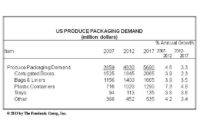Healthy eating, sustainability & convenience trends affecting packaging industry

Consumer focus on wellness, environmental impact and macroeconomic factors such as the growth of the middle class creating more disposable income are shaping the global packaging market, said Charles D. Yuska, president and CEO, PMMI, The Association for Packaging and Processing Technologies, at a press luncheon during interpack in Düsseldorf, Germany in early May.
These trends, highlighted in the 2017 Global Packaging Trends report, produced by Euromonitor and sponsored by leading packaging associations PMMI, Australian Packaging and Processing Machinery Association, Italian Manufacturers of Automatic Packing and Packaging Machinery, and the Processing & Packaging Machinery Trade Association, are impacting the types of machinery sourced by consumer packaged goods companies. Yuska cited global consumer demand for healthier foods as the impetus towards fresher food, clean labeling and organic products becoming center stage.
In particular, clean labels are becoming critical, according to PMMI’s recently released Trends in Food Processing Operations report.
“Thirty seven percent of U.S. consumers find it important to understand ingredients on food labels while 91 percent believe that products with recognizable ingredients are healthier,” Yuska said. “And, the rise in demand for organic food has fueled a more than 10 percent growth in this sector.”
In order to meet evolving customer wants, many food manufacturers are looking to new technology, such as High Pressure Processing (HPP) to extend shelf life while delivering fresher, safer food to the consumer. To help advance this technology, the Cold Pressure Council, convened by PMMI, is focused on the progression of HPP as a critical technology in the food and beverage industry.
The next trend emphasized by Yuska is the continued move to more sustainable packaging. PMMI’s 2016 Global Trends Impacting the Market for Packaging Machinery Market Research report highlighted sustainability as a key factor influencing all major regions. Customers are demanding minimal and less packaging waste while increases in the price of virgin materials are also driving demand for recycled materials.
Flexible packaging is also growing due to recyclability, affordability, lightweight and growth in packaged foods overall. This increase is especially evident in regions such as Asia Pacific, Western Europe, the Middle East and Africa. “The increased focus on sustainability drives the growing demand for more energy-efficient machines,” said Yuska. “With the growth of flexible packaging, we are seeing additional demand for filling and closing machines able to handle this type of packaging material.”
Lastly, one of the major macroeconomic trends that is impacting our industry is the growth of the middle class and a rise in disposable income. In developed regions, increased travel, busy lifestyles and growing health consciousness have increased demand for indulgent yet healthy foods, convenience foods, different portion sizes, different packaging designs and completely new foods.
“Consumer purchasing preferences are also changing. Online food sales are growing rapidly, a trend reinforced by the growing use of mobile phones and shopping applications,” adds Yuska.
Consumers welcome additional choices and are willing to pay more for products that are locally sourced, produced with quality ingredients and resonate as authentic. This trend toward more customization and increased premiumization, has fueled the need for increasingly flexible equipment that can handle shorter runs and more frequent changeovers.
Looking for a reprint of this article?
From high-res PDFs to custom plaques, order your copy today!






